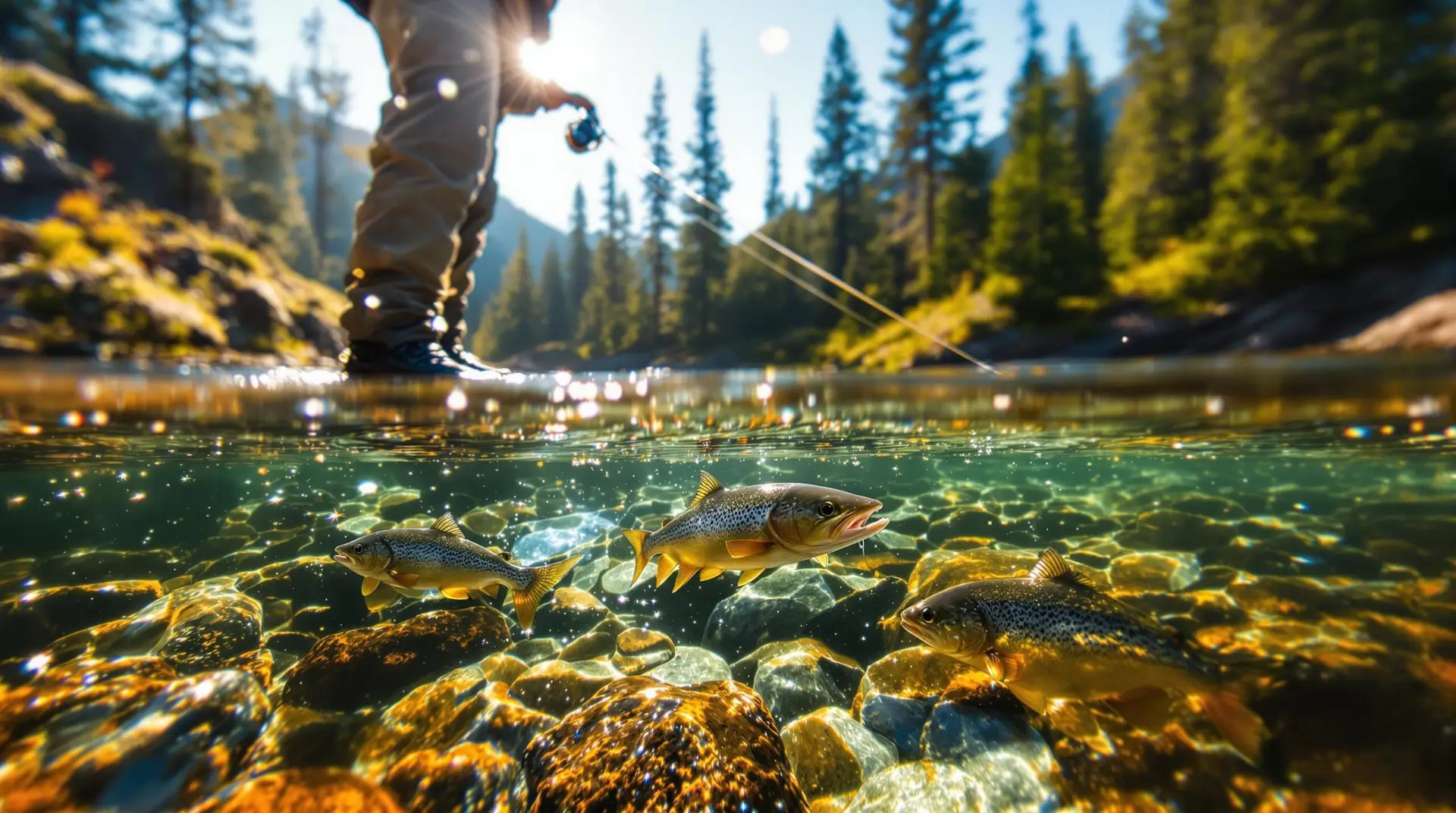Understanding Euro Nymphing
Euro nymphing is the new kid on the block in fly fishing, shaking up how things are done. Here’s the scoop on its origin story and why it’s giving indicator nymphing a run for its money.
Evolution of Euro Nymphing
Once upon a time in Eastern Europe, particularly in Czechoslovakia, Poland, and France, anglers got creative. They tweaked the Polish nymph style back in the ’80s, and thanks to some competitive Czech fishermen, the magic of Euro nymphing was born.
Before long, this technique spread faster than a viral TikTok dance among competitive fishers, thanks to its ability to work wonders in all sorts of water. Devin Olsen, the fly fishing champ with a trophy case full of World Fly Fishing Championship medals, swears by Euro nymphing’s edge in everything from bubbling brooks to deep waters (Gink & Gasoline).
Advantages Over Indicator Nymphing
Euro nymphing isn’t just another fishing fad; it’s got some real perks:
-
Feel and Hook Sensing: With the line straight to the fly, it’s like having a hotline for hook-ups. Responding quickly to fish bites is easier, upping your chances of a good catch.
-
Master of All Waters: Fast streams or lazy pools, Euro nymphing handles them all like a pro. It’s like having a Swiss army knife on a fishing rod.
-
Depth Domination: Want your fly to linger right where the fish feast? This technique’s your friend, keeping the bait exactly where it needs to be.
-
Smooth Moves: Ditch those clunky indicators dragging you down. With Euro nymphing, the fly moves naturally, making fish more likely to take the bite.
-
Catching Fire: Better control, quick responses—resulting in a bigger haul. Tight line nymphing makes sure nothing slips by unnoticed.
| Technique | Strike Detection | Depth Control | Water Type Versatility | Drift Quality | Catch Rate Potential |
|---|---|---|---|---|---|
| Euro Nymphing | High | Excellent | Versatile | Natural | High |
| Indicator Nymphing | Moderate | Good | Limited | Moderate | Moderate |
If you’re ready to level up your skills, check out our advanced euro nymphing guide for insider tips and tricks. Want to perfect your setup or choose the best bait? Dive into resources on nymph rig weight placement and nymph pattern selection. You might just reel in the catch of your dreams!
Techniques in Euro Nymphing
Euro Nymphing ain’t your average fishing style. It’s a method for those who’ve tackled regular fly fishing and want more thrills and spills on the water. Equal parts science and art, perfecting Euro Nymphing is like catching lightning in a bottle—totally worth it for fishing fans chasing bigger hauls.
Tight Line Nymphing
Tight Line Nymphing is like the superstar of euro methods. Everyone’s trying it, and who can blame them? It’s dead-on accurate and pushes your catch numbers through the roof. The trick here is to keep a taut line between your rod’s tip and your nymphs, which lets you stay ever-so-connected to your flies. Slack is the enemy. You’re looking at sharper strikes and a drift that’s as real as it gets.
Spotlight on Tight Line Nymphing:
- Always in Touch: Feel the nymphs tickle the riverbed, making it easier to pick up on those sneaky little fish.
- Feel the Buzz: Direct connection with the nymphs for a faster hook set when they get chomped.
- Master Control: Glide those nymphs like you’ve got them on remote control, even in weird water flows.
Euro Nymphing Setup
Bracing for Euro Nymphing means pimping out your gear to get the most out of your time on the water. Stick to the right rods, lines, leaders, and tippets, and you’ll be filling that net like nobody’s business.
| Gear | The Lowdown |
|---|---|
| Rod | Go for something light (2wt-4wt), 10-11 feet long, with a bendy tip to feel every nibble (Nomad Anglers). |
| Line | Grab a skinny fly line or one made for Euro, keeps drag down so your stuff drifts just right. |
| Leader | Take it long (18-20 feet) with colorful marks you can check for depth (Orvis). |
| Tippet | Skinny like a supermodel (5x-7x), hides away nice and still lets you feel hits. |
Leader Setup
Standard Euro Nymphing with your leader goes a bit like this:
- Spot the Hit: Use colored stuff in your leader to see bites as they happen.
- Keep It Real: 4-6 feet of fine tippet lets those nymphs swing naturally.
- Get Deep: Load up with heavier nymphs to reach the bottom and stay there.
Need a little more info? Check out nymphing leader setup for the down-low.
Smash those elements together, and you’ll be the boss of nymphing, with every tiny twitch or nibble giving you the heads up. Nothing boosts your fishing cred like mastering the contact nymphing technique.
Resources
Take your nymphing game further with these:
- how to euro nymph
- nymph rig weight placement
- best euro nymphing rods
- best comp nymphing lines
- nymph drift mechanics
Getting the knack of Euro Nymphing can seriously up your catch numbers. Check out special gear for Euro Nymphing to fine-tune your technique and perhaps run into some piscatorial bragging rights.
Getting the Hang of Contact Nymphing
Contact nymphing’s the fancy pants version of Euro Nymphing, focusing on keeping things tight and noticing strikes like a hawk. It’s for those fishin’ folks who wanna sharpen their skills to Jedi levels.
Basics of Contact Nymphing
The whole idea is keeping your rod tip connected to your nymph like it’s glued there. It’s all about short throws where the weight of the nymph knows just where to go. And nope, no need for those fancy tapered leaders when chucking these nymphs around (Fly Fisherman).
Here’s what you need to nail contact nymphing:
-
Line Control Like a Boss: Keep it tight. Your line’s gotta be straight from the rod tip to the nymph, so you’re ready to strike like lightning.
-
Watch and Learn: Eyes peeled for any quirky wiggles in the sighter. If it hesitates, jump on it! The “rabbit ears” trick, leaving extra thread on your knots, helps see better what’s happening underwater.
-
Smooth Moves: Achieving the perfect drift means handling your rod tip just right and watching closely for any jittery movements. Thin-profile nymphs, like the speedy Perdigon style, help keep things real down under (Fly Fisherman).
It’s All About the Thin Leaders
When it comes to contact nymphing, keeping your leader trim is key. Slimmer lines help keep that tight connection between your rod tip and the nibbling nymph, so you’re ready to pounce the moment a trout takes the bait.
Why Thin Leaders Rock:
-
Fast Strikes: Less meat on those leaders means faster strike reactions.
-
Natural Drift Gold: Lets your nymph swim more naturally through deep waters instead of tugging it around.
-
No Bowlines Here: Thin, tough lines keep it straight as an arrow, perfect for those critters who nibble lightly. This “thin to win” idea rules the roost in contact nymphing (Fly Fisherman).
Handy Table: Leader Thickness & Fast Strikes
| Leader Type | Thickness (mm) | Strike Speed |
|---|---|---|
| Regular Nylon | 0.20 | Just Okay |
| Competitive Mono | 0.12 | Pretty Fast |
| Super Thin Fluoro | 0.10 | Lightning |
Check out more nitty-gritty on gettin’ your leader just right in our article on nymphing leader setup.
By nailin’ contact nymphing and grasping why thin leaders matter, dedicated fly fishers get a massive jump in spotting strikes and catching fish. Trying out new nymph patterns, like those shared in our nymph pattern selection, lets you adapt to all sorts of water antics. Happy fishing!
Enhancing Nymphing Skills
To really nail the contact nymphing game, anglers gotta fine-tune those skills in feeling out the strikes and get the right gear for Euro Nymphing. Let’s jump into these pro tips and tricks.
Strike Detection Strategies
Being able to spot a strike is a game-changer in nymphing. Anglers usually use their hands and eyes to pick up on strikes. Let’s check out how you can up your strike detection game:
Feeling the Strike
- A 20-30 foot thin monofilament leader makes it easier to feel those sneaky strikes just by using the rod tip (Thanks Orvis for the insight!).
- Try the Mono Rig with Maxima Chameleon or Amnesia; those materials help you feel even the softest nibbles without any drag getting in the way (Troutbitten says so).
Spotting with Your Eyes
- Add colored sections in your leader to see how deep your fly’s swimming, keeping you constantly in touch with where you’re fishing.
- Keep an eye out for any weird wiggles or pauses in the leader—that’s your clue!
Specialized Equipment for Euro Nymphing
Euro Nymphing calls for some specific gadgets beyond the run-of-the-mill fly fishing stuff. The right tools mean you’ve got better grip on the situation.
Euro Nymphing Rods
- Go for rods that are designed for Euro Nymphing, generally longer (10-11 feet) to help with reach and feeling out those bites.
- Look for rods that can feel but also handle bigger fish when needed.
| Equipment Type | Recommended Specification |
|---|---|
| Rod Length | 10 – 11 feet |
| Rod Weight | 2 – 4 |
Leaders and Lines
- A nymphing leader setup with long, thin monofilament leaders ramps up the sensitivity.
- Check out Euro Nymphing-specific lines—they’re better at spreading the weight and staying in control.
Tippet and Indicators
- Use thin, tough tippet like fluorocarbon; it sinks better and is sneakier under the water.
- Get the best nymph indicators which change color to show strikes easier.
Additional Tools
- Have lightweight nets, hemostats, and fly boxes filled with jig-style nymphs handy for quick action.
- Special euro nymphing tools can give your gear a boost in function and upkeep.
Excelling in Euro Nymphing is all about mixing the right tactics and tools. For more on advanced tweaks and tips, take a look at our full guide on technical nymph fishing.

